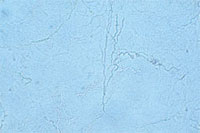|
| Fig. 3.1 Refractile and cylindrical hyphae traversing KOH preparation of skin scraping. |
The highest rate of recovery of organisms occurs in specimens taken from the tops of vesicles, the leading edges of annular lesions, or deep scrapings from the nails suspected to be infected with fungi. The site should be swabbed with an alcohol pad or water and scraped with a no. 15 blade. In some instances, such as the scalp or nail, a curette may be more effective. The moist corneocytes are then easily transferred from the blade to a glass slide. One or two drops of KOH (10% to 20%) are added, and a coverslip is applied to the specimen. The KOH preparation is gently warmed, but not boiled, and then examined under the microscope. It is important to focus back and forth through the material so that the refractile hyphae can be visualized. Fungal hyphae can be recognized by their regular cylindrical shapes with branching and the presence of septae that may demonstrate a subtle greenish hue (Fig. 3-1). A pencil eraser or pen cap gently applied to the surface of the coverslip may enhance keratinocyte breakdown, especially for clumped specimens. If no organisms are observed initially, waiting 10 to 15 minutes may aid visualization.
